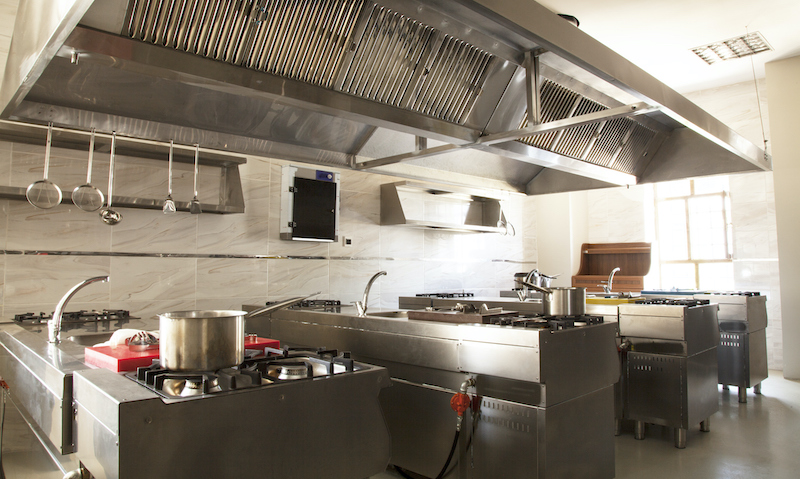
Online-only cooking warehouses are on the rise—but they may evade traditional food safety regulations.
In Minnesota’s Twin Cities, four food vendors in the same food hall prepare dishes available only online. In San Francisco, a single cooking facility provides kitchen space for dozens of delivery-only enterprises. In New York City, a popular restaurant chain has opened its first physical site dedicated solely to food collection and delivery.
Referred to as ghost kitchens or “headless restaurants,” all of these cooking facilities operate only for food delivery purposes. They do not have seating, a storefront, or wait staff. Instead, they exist in the amorphous space of online ordering, which has steadily increased during the pandemic.
Because ghost kitchens do not fit the traditional definition of a restaurant, government officials are unsure how to regulate them. Earlier this year, New York City and San Francisco officials recognized the need for regulatory oversight and convened hearings to address the impact of ghost kitchens.
In particular, government officials are concerned about food safety requirements. Depending on their operations, ghost kitchens may fall under the definition of “food facilities,” which the U.S. Food and Drug Administration (FDA) defines as facilities that manufacture, process, pack, or hold food for consumption. These facilities must be registered with FDA and are subject to FDA inspections. They also must abide by various safety requirements, including allergy management, hazard planning, and sanitation requirements.
If a kitchen is defined as a restaurant—“a facility that prepares and sells food directly to consumers for immediate consumption”—it is exempt from FDA registration, but still regulated by state codes and local health authorities. Central kitchens that prepare food for a restaurant chain do not fall under the restaurant exemption unless they sell directly to consumers. In sum, although some ghost kitchens may be exempt from FDA registration, all must follow certain safety standards.
Ghost kitchens must abide by food safety regulations, but it is not easy for customers to learn whether these facilities are in compliance. Because of the virtual nature of ghost kitchens, consumers cannot access health inspection letter grades as readily as they could at traditional restaurants, which may be required to display proof of inspection in their storefronts or dining areas.
Even if consumers can access letter grades via city health department websites, information can be difficult or nearly impossible to find. For example, New York City councilman Mark Gjonaj posed the possible scenario in which a food facility could bury its low inspection rating by operating under other names that are not in the grade system. With the possibility that vendors could, unbeknownst to customers, distribute poorly graded food, “alarms and bells should be ringing in our minds,” said Gjonaj.
Moreover, these letter grades may not account for all health violations found in ghost kitchen facilities. If inspectors find a health violation in a shared space of a ghost kitchen, such as a corridor or freezer that all the vendors use, they issue the violation only to the overall leaseholder.
Consider, for example, the situation in which a multi-vendor ghost kitchen does not receive a health inspection grade, but the individual food vendors do. If that ghost kitchen has a health violation in one of its common areas, it might be fined and penalized. But consumers would not be able to access that information because the violation would not impact the letter grades of the shared kitchen vendors. On the other hand, the grade of a brick-and-mortar store would reflect a health violation that occurs in a common space.
Regulators need to wrestle with how to address ghost kitchens, especially because ghost kitchens have been expanding. Ghost kitchens are significantly cheaper to run than traditional restaurants because of reduced overhead costs. Cost-effective operations, coupled with the allure of food delivery, have led to growing momentum. Most notably, former executives at a popular ride-sharing company have been battling each other in the virtual kitchen space, raising millions of dollars in capital.
One avenue for reform is for food delivery entities to disclose the inspection grades of the ghost kitchens they service. The letter grades should be as easy for consumers to access as it is to select and pay for food. Another option would be for local health authorities to include inspection ratings for ghost kitchens that host more than one vendor to address concerns about shared spaces.
For now, especially because of the current pandemic, ghost kitchens are likely to remain prevalent. For many consumers, ordering online is a safer, preferred alternative to on-site dining. And for local food vendors, operating with a kitchen instead of a storefront may ease economic strain and allow them to stay afloat.
Despite those benefits, government officials insist that ghost kitchens should be transparent about food safety. In response, policymakers are considering how to adapt existing regulations to fit the unique challenges that ghost kitchens present.



